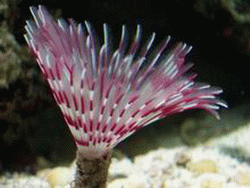While there are normaly not a great variety of worms available on the
market, those that we are able to purchase do have specific needs which
as with all other pets must be met. The following links will provide
the guidelines needed to ensure you have your pet for a good long time.
For those of us who use live rock and / or live sand, it is also a good
idea to become familiar with the variety of worm species that may htich
hike a ride into our tanks while hiding in the rock and sand that we
add. The majority of such species pose no real danger but as with any
family or genus of worms, there are those members that are predatory of
other life forms that we wish to remain in our aquariums. I also want
to stress that many of the worm species do perform a great service to
our systems in numerous ways. Keeping with the concept of a "reef",
knowing what and how they are being of service should be of great
interest to us.
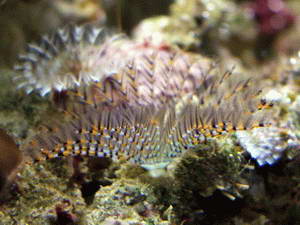

Often overlooked, or worse, looked upon as a problem to be dealt
with, a great many of the worms that do find their way into our
aquariums as hitch hikers are often the unsung heros of the clean up
crew. The majority of the time, I think such attitudes towards
such worms stems from the fact that they create an "icky" factor when
seen, such prejudice leads to them being labeled as bad or being
unfairly accused of causing other problems.
Besides
being execllent at cleaning up around the house, they also provide a
great deal of free live food for the majority of the other aquarium
inhabitants through their spawning. Many corals and even fish will find
a good deal of free, live food while the worms also clean up after the
corals and fish as well.
Below are just a few of the
many examples of worm families that can and will be of great benefit to
any system. All of which are harmless to all other inhabitants of a
typical reef aquarium.
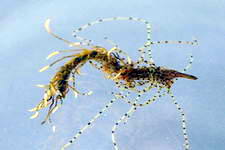
Cirratulids (aka hair worms) are deposit feeders which gather food from the sea bottom by means
of their palps. They are sluggish worms which bury themselves below the surface
of sea bottoms leaving only their gills and palps visible. Some are free-living
and inhabit tubes, while others are capable of burrowing through corals, shell
or rock.
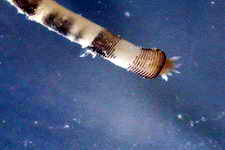
Sipunculida (aka peanut worms) are another of the many detrivores
that spend their time mopping up excess detritus and left over food
particles.
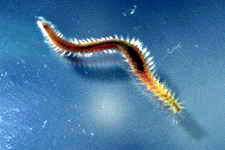
The Bristleworms, a great many species which are most always the
backbone of any clean up crew. This family of worms is by far, the most
often to be wrongly accused of causing problems within aquariums. While
at times, their populations may seem to "explode", and appear to be
becoming a problem, this would of course be your fault. Such population
explosions most always indicate that the aquarium is being fed too much
food, which as any animal will do, they take advantage of such an
envrionment and swell their levels to match the exsisting food supply.

The Capitellidae, they appear and behave much like the earthworms
found in your backyard garden. Injesting soft muddy substrates to
gather and inject any organic materials.
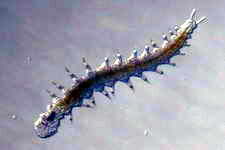
The Dorvilleidae, members of this family are much smaller than most of the more larger, visible
families and pose no real threat to other life in our aquariums. They will
appear as very small white lines on the glass of our aquariums and are very
common. Each specimen that I have examined under a microscope appears to be gut
loaded with algae.


The Terebellidae (aka spaghetti worms), One of the most
commonly found worms that hitch in with live rock and sand and soon
become very valuable members of any system. Usualy the only visible
signs of their presence are when they extend their feeding tentacles
out across the rocks and sand to mop up and organic debris.
There are of course a great many other worms families / species
that are not only of great service to our aquariums, but also increase
ones enjoyment of having a reef aquariums that contains so much more
than just corals and fish. For Identification of worms, please see the
relevant section of the Hitch Hiker page as found off of the "info
links" menu.



 Cirratulids (aka hair worms) are deposit feeders which gather food from the sea bottom by means
of their palps. They are sluggish worms which bury themselves below the surface
of sea bottoms leaving only their gills and palps visible. Some are free-living
and inhabit tubes, while others are capable of burrowing through corals, shell
or rock.
Cirratulids (aka hair worms) are deposit feeders which gather food from the sea bottom by means
of their palps. They are sluggish worms which bury themselves below the surface
of sea bottoms leaving only their gills and palps visible. Some are free-living
and inhabit tubes, while others are capable of burrowing through corals, shell
or rock. Sipunculida (aka peanut worms) are another of the many detrivores
that spend their time mopping up excess detritus and left over food
particles.
Sipunculida (aka peanut worms) are another of the many detrivores
that spend their time mopping up excess detritus and left over food
particles.  The Bristleworms, a great many species which are most always the
backbone of any clean up crew. This family of worms is by far, the most
often to be wrongly accused of causing problems within aquariums. While
at times, their populations may seem to "explode", and appear to be
becoming a problem, this would of course be your fault. Such population
explosions most always indicate that the aquarium is being fed too much
food, which as any animal will do, they take advantage of such an
envrionment and swell their levels to match the exsisting food supply.
The Bristleworms, a great many species which are most always the
backbone of any clean up crew. This family of worms is by far, the most
often to be wrongly accused of causing problems within aquariums. While
at times, their populations may seem to "explode", and appear to be
becoming a problem, this would of course be your fault. Such population
explosions most always indicate that the aquarium is being fed too much
food, which as any animal will do, they take advantage of such an
envrionment and swell their levels to match the exsisting food supply.  The Capitellidae, they appear and behave much like the earthworms
found in your backyard garden. Injesting soft muddy substrates to
gather and inject any organic materials.
The Capitellidae, they appear and behave much like the earthworms
found in your backyard garden. Injesting soft muddy substrates to
gather and inject any organic materials.  The Dorvilleidae, members of this family are much smaller than most of the more larger, visible
families and pose no real threat to other life in our aquariums. They will
appear as very small white lines on the glass of our aquariums and are very
common. Each specimen that I have examined under a microscope appears to be gut
loaded with algae.
The Dorvilleidae, members of this family are much smaller than most of the more larger, visible
families and pose no real threat to other life in our aquariums. They will
appear as very small white lines on the glass of our aquariums and are very
common. Each specimen that I have examined under a microscope appears to be gut
loaded with algae.
 The Terebellidae (aka spaghetti worms), One of the most
commonly found worms that hitch in with live rock and sand and soon
become very valuable members of any system. Usualy the only visible
signs of their presence are when they extend their feeding tentacles
out across the rocks and sand to mop up and organic debris.
The Terebellidae (aka spaghetti worms), One of the most
commonly found worms that hitch in with live rock and sand and soon
become very valuable members of any system. Usualy the only visible
signs of their presence are when they extend their feeding tentacles
out across the rocks and sand to mop up and organic debris.